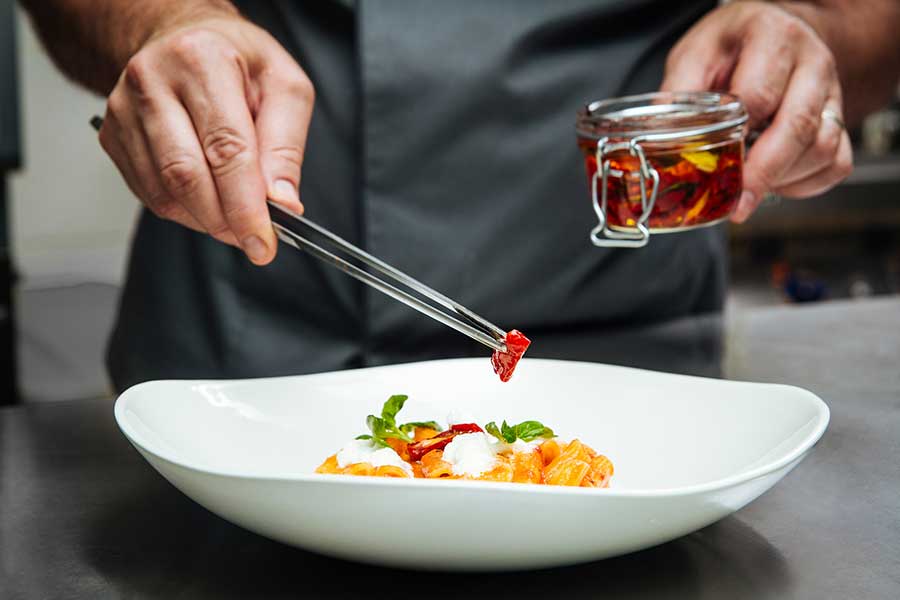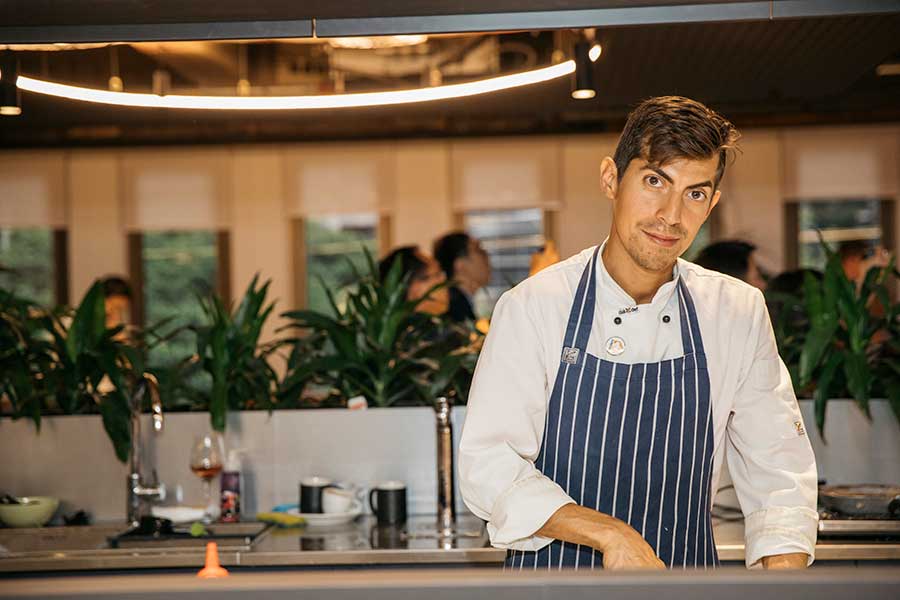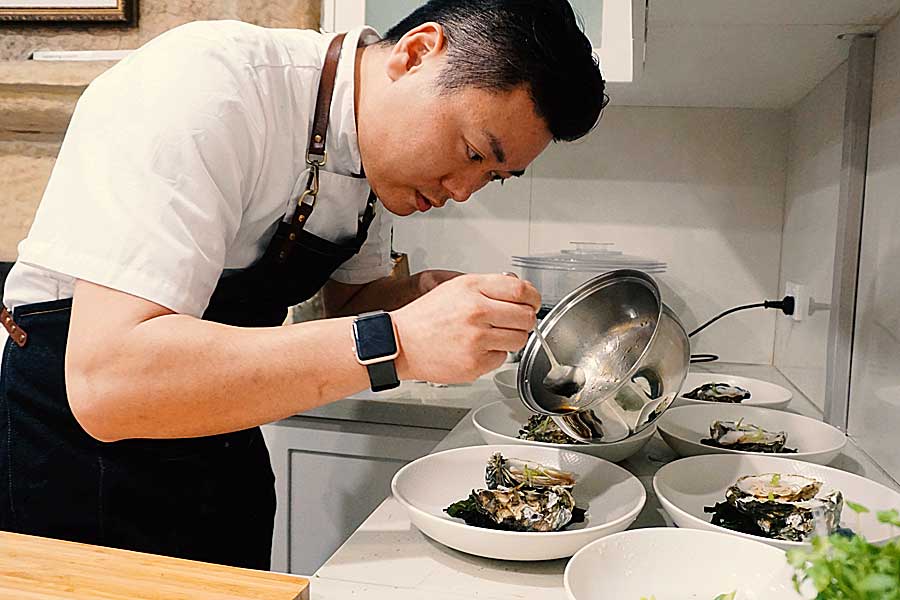A private chef’s creations might look effortless, but the behind-the-scenes is a different story. It’s a whirlwind of choosing ingredients, brainstorming, harmonising, layering, structuring, and presenting. There are wrong decisions, right decisions, guesswork, and a whole lot of intuition behind developing a dish.
In our opinion, watching a chef develop a dish is the same as watching an artist bring a canvas to life. It’s a wonderful, eye-opening insight into the mind of a creative. We can see how a set of formulas, techniques, and know-how all come together to create an amazing end result.
If you’ve booked in a private chef for your event, are hosting a chef’s audition in your home, or just want to learn how chefs develop their own unique dishes, here’s a short walkthrough. From ingredients to plating up, here’s how our personal chefs work on creating their incredible meals.
Step 1: Select ingredients like a private chef
First port of call when developing a dish is to make a list of ingredients. Skip this step and you may end up with a disaster of clashing flavours and disharmony. Our private chefs will trawl through farmer’s markets, delicatessens, and community gardens to gather inspiration for their dish’s ingredients. They’ll look at what’s around them and start planning their meal based on availability – what produce is in season, what cuts of meat look enticing at the butcher, what types of seafood have been caught that morning.
Of course, every chef also has a list of ingredients that they love to cook with. Things they know and love, flavour profiles they like to go for, and unique combinations that give dishes their signature twist. And then there’s that list of ingredients at the back of a chef’s mind. These are inspiring ingredients that are waiting for the right opportunity to come up. They could be more obscure, hard to get, or hard to combine. This list is just waiting for that right dish to come up…

Step 2: Build a flavour profile like a private chef
If cooking was as easy as throwing ingredients into a pan and hoping for the best, there’d be no need for a private chef! We’ve all had dishes that didn’t taste quite right and others that seem to sing in our mouths, and that’s where the real science of cooking comes in. With their ingredients chosen, our chefs then start considering how to balance the flavours in their dish. This is the real secret behind how a seemingly simple dish can taste complex and powerful – whether they’ve chosen 3 ingredients or 30.
Building a balanced flavour profile is all about knowing how the different taste elements interact within a meal. The 5 basic tastes are sweet, sour, salty, bitter, and umami and each will either enhance or balance the flavour of another. Here’s a private chef’s basic rundown on how the taste elements interact within a dish:
Taste elements in cooking like a private chef
- Sweet – The sweet taste counteracts bitter and sour flavours, as well as turning down the heat on an extra spicy meal. Consider ingredients like honey, sugar, syrup, and fruits.
- Sour – The sour taste adds acidity to a dish, balancing all of the flavours and adding an extra layer of life to a dish. It also helps reduce the sweetness or spiciness of a dish. A squeeze of lemon or dash of vinegar is the perfect sour component to a dish.
- Salty – Salt is the best flavour enhancer there is! Adding salt brings out all of the other flavours in the dish, making more subtle tastes more prominent.
- Bitter – It’s not the most popular flavour around, but bitterness can bring great balance to a meal. The bitter taste helps counteract dishes that are too rich, sweet, or heavy – think things like beer, rinds, or bitter greens.
- Umami – A hard-to-define flavour that’s found in soy sauce, mushrooms, oysters, cheese, and meat, umami brings balance to a dish and complements all other flavours without stealing the show.
A chef might start off by limiting themselves to a couple of different flavour profiles, then slowly adding components to build texture and complexity. While it may be tempting to go all out and use everything in one dish, simplicity is key. Chefs will start simple and layer their flavour profiles to build more structure and add variability to the dish.
With the above theory about taste elements in mind, it’s hard to get a dish wrong. And that’s how chefs can throw in unusual ingredients and unheard-of combinations and still make it work on the plate. You can create an outstanding dish from a traditional recipe by substituting one ingredient for another – using, say, pomegranate molasses instead of lemon to add that sour element. Know how each of your ingredients will taste and interact on the plate, and you’ll have a recipe for a party in your mouth.
Step 3: Design the plate
Everyone knows you eat with your eyes before your mouth and leaving plate design to the last minute is a rookie error that a private chef can’t gamble with. Chefs should start brainstorming how the plate will look before they’ve finalised the dish to make sure it’s presentable and attractive to the eyes of the guests. Some things to consider – besides presentation – is how the guests will eat the dish, what components should be eaten first so as to be had at the right temperature, which items should go on the spoon or fork at the same time, and so on.
Here, our private chefs will use their own creative magic to make plates interactive, attractive, and easy-to-eat. They may choose to serve canapes on a spoon, or group particular elements of a dish together. They might flick through photographs to gather inspiration from other dishes and plating up styles, and tweak them to suit their own dish. Another handy exercise is to design the plating style and then work backwards from there, considering how to lay out the different components and make them work.
Then it’s drawing time! Our chefs will sketch potential designs on a whiteboard or sketchbook, developing a few different ideas and putting pen to paper to see how well the dish will work. Sketching designs for plating helps confirm the feasibility of the dish, as well as whether there’s a need to add secondary components for extra flavour, texture, and appearance.
Step 4: Tasting time
Finally, it’s time to put the new dish to the test! When testing out new dishes, chefs will typically forego the best cuts of meat and best parts of the vegetable, and make a ‘lesser’ version of the dish to test out. This will help them understand how well the dish works in different circumstances – sometimes using more abundant parts of a plant or less desirable parts of an ingredient.
At this point in time, chefs can also still experiment and play around with texture, flavour, and plating. They might choose to puree peanuts instead of crushing them, add a different kind of cheese or herb to a dish, or switch from a bowl to a flat plate. In this tasting stage, our personal chefs may choose to experiment with a few different variations of the same dish, each with its own presentation and texture. It’s all about perfecting the final elements before taking the dish to the client – you!
Get up close and personal with a chef
Want to know more? Want to see a personal chef in action? It’s easy. Whether you’re hosting an event, want a cooking class, or just want to experience what it’s like to have a chef personally cook for you, we can help. Our team of chefs are extremely well-trained, talented, and each has their own unique skills in the kitchen. Ask them questions, watch them prep, cook, and serve, and just enjoy the interaction with your chef. Book your private chef now and enjoy a fine dining meal from wherever you are!

